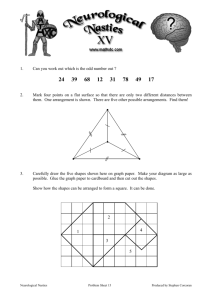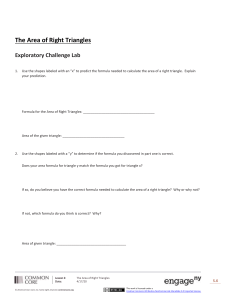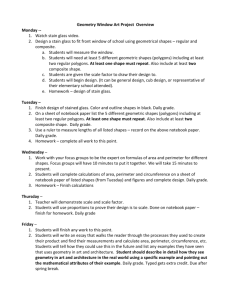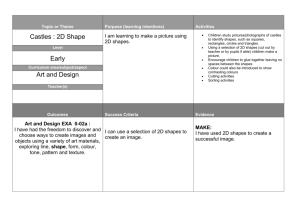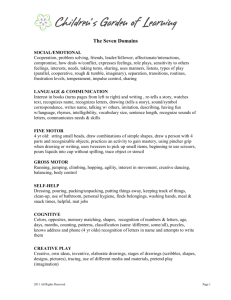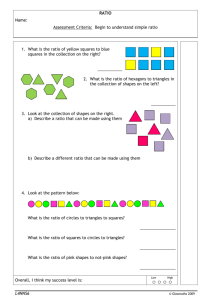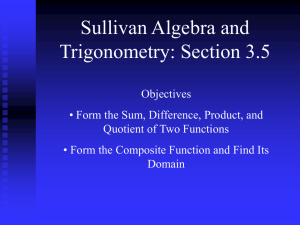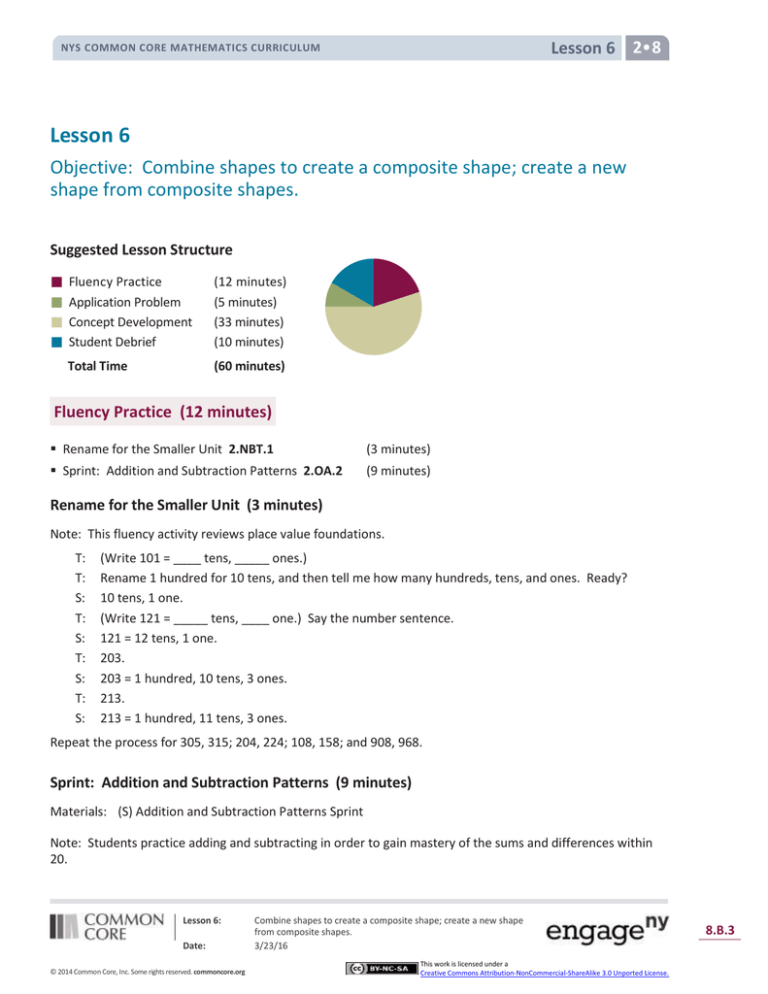
Lesson 6 2•8
NYS COMMON CORE MATHEMATICS CURRICULUM
Lesson 6
Objective: Combine shapes to create a composite shape; create a new
shape from composite shapes.
Suggested Lesson Structure
Fluency Practice
Application Problem
Concept Development
Student Debrief
Total Time
(12 minutes)
(5 minutes)
(33 minutes)
(10 minutes)
(60 minutes)
Fluency Practice (12 minutes)
Rename for the Smaller Unit 2.NBT.1
(3 minutes)
Sprint: Addition and Subtraction Patterns 2.OA.2
(9 minutes)
Rename for the Smaller Unit (3 minutes)
Note: This fluency activity reviews place value foundations.
T:
T:
S:
T:
S:
T:
S:
T:
S:
(Write 101 = ____ tens, _____ ones.)
Rename 1 hundred for 10 tens, and then tell me how many hundreds, tens, and ones. Ready?
10 tens, 1 one.
(Write 121 = _____ tens, ____ one.) Say the number sentence.
121 = 12 tens, 1 one.
203.
203 = 1 hundred, 10 tens, 3 ones.
213.
213 = 1 hundred, 11 tens, 3 ones.
Repeat the process for 305, 315; 204, 224; 108, 158; and 908, 968.
Sprint: Addition and Subtraction Patterns (9 minutes)
Materials: (S) Addition and Subtraction Patterns Sprint
Note: Students practice adding and subtracting in order to gain mastery of the sums and differences within
20.
Lesson 6:
Date:
© 2014 Common Core, Inc. Some rights reserved. commoncore.org
Combine shapes to create a composite shape; create a new shape
from composite shapes.
3/23/16
This work is licensed under a
Creative Commons Attribution-NonCommercial-ShareAlike 3.0 Unported License.
8.B.3
Lesson 6 2•8
NYS COMMON CORE MATHEMATICS CURRICULUM
Application Problem (5 minutes)
Frank has 19 fewer cubes than Josie. Frank has 56
cubes. They want to use all of their cubes to build a
tower. How many cubes will they use?
Note: This is a two-step problem with a compare with bigger unknown type problem as one step. Encourage
students to draw a tape diagram to help visualize the comparison.
Concept Development (33 minutes)
Materials: (T) Tangram sheet (template), scissors, document camera (if available) (S) Tangram sheet
(template), scissors, personal white board
Note: Students previously worked with tangrams in G1−M5−Lesson 5. If
time allows, refresh students’ memory by reading Grandfather Tang’s
Story by Ann Tompert during story time.
Distribute materials. (Students will also need the cut-out tangram pieces
for G2−M8−Lesson 8.)
Part 1: Cutting the Tangram and Analyzing the Polygons
T:
S:
T:
T:
T:
(Hold up tangram sheet.) Who remembers what this is called?
A tangram!
Let’s describe the polygons as we cut them out.
First, cut out the large square. (Cut out large square from tangram sheet as students do the same.)
(Hold up tangram backwards so students do not see the lines
within.) As you cut, talk to your partner: What are the attributes,
or characteristics, of a square?
S: A square has four straight sides and four square corners. It’s a
special rectangle because its sides are all the same length. It’s a
quadrilateral. It has parallel sides.
T: Good descriptions! Watch how I fold my large square down the
diagonal line that goes through the middle. (Fold paper.) What
polygon do you see in the top half?
S: A triangle!
T: As you cut out the triangle, tell your partner the attributes of a
triangle.
S: A triangle has three straight sides. It has three angles, or corners.
This triangle has a square corner.
T: (Hold up the triangle.) How many triangles make up this whole
triangle?
Lesson 6:
Date:
© 2014 Common Core, Inc. Some rights reserved. commoncore.org
Combine shapes to create a composite shape; create a new shape
from composite shapes.
3/23/16
This work is licensed under a
Creative Commons Attribution-NonCommercial-ShareAlike 3.0 Unported License.
8.B.4
Lesson 6 2•8
NYS COMMON CORE MATHEMATICS CURRICULUM
S:
T:
T:
T:
S:
T:
S:
MP.6 T:
T:
S:
Two!
So we can make larger polygons, out of smaller ones.
Cut apart the two smaller triangles, and set them aside. (Model as
students do the same.)
Look at the other half. (Hold up the other large triangle, pictured
to the right.) What polygons do you see inside this triangle?
I see two smaller triangles and one bigger triangle. I see two
trapezoids. There’s a square. There’s a parallelogram.
Which of the shapes are quadrilaterals? Hold them up as you say their names.
The square. The parallelogram. The trapezoids.
Let’s cut off the triangle on top and place that with the other two. (Model as students do the same.)
Now we have the large trapezoid. What are the
attributes of this trapezoid?
NOTES ON
It has four straight sides, but they’re not all the same
MULTIPLE MEANS OF
length. This trapezoid has four corners, but they’re
not square corners. It has just one pair of parallel
ENGAGEMENT:
sides.
Support English language learners’ oral
language production by providing
sentence frames such as, “I see _____
parallelograms because I see a
______,” to use in partner turn and
talks.
Next, cut off the parallelogram and trace, touch, and count its
sides and angles. Cut out the remaining square and two
triangles.
T:
S:
How many polygons make up the tangram?
Seven!
Part 2: Creating Composite Shapes
Allow time for students to explore ways to create new shapes. They do
not have to be shapes that students can name. Remind students that
they can flip, slide, and turn the pieces to make the new shapes.
Next, direct student pairs to create three shapes, a triangle, a square, and
a parallelogram with no square corners (as pictured to the right), using
the two largest triangles. After creating the shapes, students should
draw them on their personal boards. Circulate to check for
understanding, and encourage students to persevere, providing the least
direction possible.
Have students gather their square and the two smallest triangles and
move to the carpet.
T:
T:
Try this! Can you create a triangle out of a square and the two smallest triangles? (Allow students
time to work.)
Now, combine the triangle you just made with your
partner’s to make a square. (Allow students time to
work.)
Lesson 6:
Date:
© 2014 Common Core, Inc. Some rights reserved. commoncore.org
Combine shapes to create a composite shape; create a new shape
from composite shapes.
3/23/16
This work is licensed under a
Creative Commons Attribution-NonCommercial-ShareAlike 3.0 Unported License.
8.B.5
Lesson 6 2•8
NYS COMMON CORE MATHEMATICS CURRICULUM
T:
S:
T:
Is it possible for us to make a really big square
with all of the squares you just made?
I think so. Let’s try! I don’t think we have
enough.
Let’s try. (Allow time for students to make the
attempt. Ability to make a square will depend on
the number of students in the class. If it is not
possible to make a square, ask what shape could
be made, and allow time to make a rectangle.)
Problem Set (10 minutes)
Students should do their personal best to complete the
Problem Set within the allotted 10 minutes. For some
classes, it may be appropriate to modify the assignment by
specifying which problems they work on first. Some
problems do not specify a method for solving. Students
solve these problems using the RDW approach used for
Application Problems.
Note: Challenge early finishers to reassemble the
tangram.
Student Debrief (10 minutes)
Lesson Objective: Combine shapes to create a composite
shape; create a new shape from composite shapes.
The Student Debrief is intended to invite reflection and
active processing of the total lesson experience.
Invite students to review their solutions for the Problem
Set. They should check work by comparing answers with a
partner before going over answers as a class. Look for
misconceptions or misunderstandings that can be
addressed in the Debrief. Guide students in a conversation
to debrief the Problem Set and process the lesson.
You may choose to use any combination of the questions
below to lead the discussion.
Share the polygons you made in Problem 5 with
your partner. Describe the attributes of each polygon.
Why do you think we used tangrams for this lesson?
Can you think of any real world objects that are made up of lots of smaller shapes? (Provide an
example to get students started if needed: tile floor, window blinds, chain-link fence, Legos, brick
wall.)
Lesson 6:
Date:
© 2014 Common Core, Inc. Some rights reserved. commoncore.org
Combine shapes to create a composite shape; create a new shape
from composite shapes.
3/23/16
This work is licensed under a
Creative Commons Attribution-NonCommercial-ShareAlike 3.0 Unported License.
8.B.6
Lesson 6 2•8
NYS COMMON CORE MATHEMATICS CURRICULUM
How is breaking big shapes into smaller shapes kind of
like decomposing numbers? Pennies and dimes?
Centimeters and meters?
Are all squares parallelograms? How can you prove
that? Are all parallelograms squares?
How is Frank and Josie’s tower of cubes from the
Application Problem similar to what we did today?
Exit Ticket (3 minutes)
After the Student Debrief, instruct students to complete the Exit
Ticket. A review of their work will help you assess the students’
understanding of the concepts that were presented in the
lesson today and plan more effectively for future lessons. You
may read the questions aloud to the students.
Lesson 6:
Date:
© 2014 Common Core, Inc. Some rights reserved. commoncore.org
NOTES ON
MULTIPLE MEANS OF
ACTION AND
EXPRESSION:
Challenge above grade level students
by asking them to reconstruct the
original square using the seven
tangram pieces. A further challenge
would be for them to use all seven
pieces to make one large rectangle.
Combine shapes to create a composite shape; create a new shape
from composite shapes.
3/23/16
This work is licensed under a
Creative Commons Attribution-NonCommercial-ShareAlike 3.0 Unported License.
8.B.7
NYS COMMON CORE MATHEMATICS CURRICULUM
Lesson 6:
Date:
© 2014 Common Core, Inc. Some rights reserved. commoncore.org
Lesson 6 Sprint 2•8
Combine shapes to create a composite shape; create a new shape
from composite shapes.
3/23/16
This work is licensed under a
Creative Commons Attribution-NonCommercial-ShareAlike 3.0 Unported License.
8.B.8
NYS COMMON CORE MATHEMATICS CURRICULUM
Lesson 6:
Date:
© 2014 Common Core, Inc. Some rights reserved. commoncore.org
Lesson 6 Sprint 2•8
Combine shapes to create a composite shape; create a new shape
from composite shapes.
3/23/16
This work is licensed under a
Creative Commons Attribution-NonCommercial-ShareAlike 3.0 Unported License.
8.B.9
Lesson 6 Problem Set 2•8
NYS COMMON CORE MATHEMATICS CURRICULUM
Name
Date
1. Identify each polygon labeled in the tangram as
precisely as possible in the space below.
a.
b.
a. ______________________
c.
b. ______________________
c. ______________________
2. Use the square and the two smallest triangles to make the following polygons. Draw
them in the space provided.
a. A quadrilateral with 1 pair of
parallel sides.
b. A quadrilateral with no square
corners.
c. A quadrilateral with 4 square
corners.
d. A triangle with 1 square corner.
Lesson 6:
Date:
© 2014 Common Core, Inc. Some rights reserved. commoncore.org
Combine shapes to create a composite shape; create a new shape
from composite shapes.
3/23/16
This work is licensed under a
Creative Commons Attribution-NonCommercial-ShareAlike 3.0 Unported License.
8.B.10
NYS COMMON CORE MATHEMATICS CURRICULUM
Lesson 6 Problem Set 2•8
3. Use the parallelogram and the two smallest triangles to make the following polygons.
Draw them in the space provided.
a. A quadrilateral with 1 pair of
parallel sides.
b. A quadrilateral with no square
corners.
c. A quadrilateral with 4 square
corners.
d. A triangle with 1 square corner.
4. Rearrange the parallelogram and the two smallest triangles to make a hexagon.
Draw the new shape below.
5. Rearrange your tangram pieces to make other polygons! Identify them as you work.
Lesson 6:
Date:
© 2014 Common Core, Inc. Some rights reserved. commoncore.org
Combine shapes to create a composite shape; create a new shape
from composite shapes.
3/23/16
This work is licensed under a
Creative Commons Attribution-NonCommercial-ShareAlike 3.0 Unported License.
8.B.11
NYS COMMON CORE MATHEMATICS CURRICULUM
Name
Lesson 6 Exit Ticket 2•8
Date
Use your tangram pieces to make two new polygons. Draw a picture, and identify them.
1.
2.
Lesson 6:
Date:
© 2014 Common Core, Inc. Some rights reserved. commoncore.org
Combine shapes to create a composite shape; create a new shape
from composite shapes.
3/23/16
This work is licensed under a
Creative Commons Attribution-NonCommercial-ShareAlike 3.0 Unported License.
8.B.12
Lesson 6 Homework 2•8
NYS COMMON CORE MATHEMATICS CURRICULUM
Name
Date
1. Identify each polygon labeled in the tangram as
precisely as possible in the space below.
b.
a.
a. ______________________
b. ______________________
c.
c. ______________________
2. Use the square and the two smallest triangles to make the following polygons. Draw
them in the space provided.
a. A triangle with 1 square corner.
b.
A quadrilateral with 4 square
corners.
c.
d.
A quadrilateral with only 1 pair of
parallel sides.
A quadrilateral with no square
corners.
Lesson 6:
Date:
© 2014 Common Core, Inc. Some rights reserved. commoncore.org
Combine shapes to create a composite shape; create a new shape
from composite shapes.
3/23/16
This work is licensed under a
Creative Commons Attribution-NonCommercial-ShareAlike 3.0 Unported License.
8.B.13
NYS COMMON CORE MATHEMATICS CURRICULUM
Lesson 6 Homework 2•8
3. Rearrange the parallelogram and the two smallest triangles to make a hexagon.
Draw the new shape below.
4. Rearrange your tangram pieces to make at least 6 other polygons! Draw and identify
your favorites below.
Lesson 6:
Date:
© 2014 Common Core, Inc. Some rights reserved. commoncore.org
Combine shapes to create a composite shape; create a new shape
from composite shapes.
3/23/16
This work is licensed under a
Creative Commons Attribution-NonCommercial-ShareAlike 3.0 Unported License.
8.B.14
NYS COMMON CORE MATHEMATICS CURRICULUM
Lesson 6 Template 2•8
Cut out the tangram into 7 puzzle pieces.
Lesson 6:
Date:
© 2014 Common Core, Inc. Some rights reserved. commoncore.org
Combine shapes to create a composite shape; create a new shape
from composite shapes.
3/23/16
This work is licensed under a
Creative Commons Attribution-NonCommercial-ShareAlike 3.0 Unported License.
8.B.15

